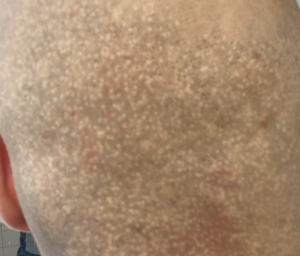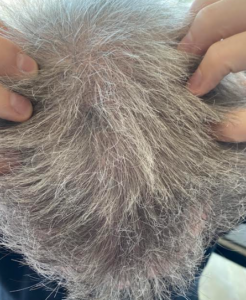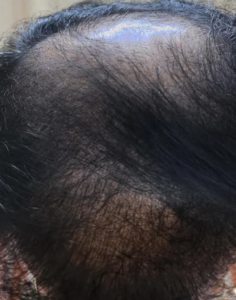I was shocked at the scarring I got from the FUE. Nobody told me that this was a risk. I am going to grow my hair right back to hide this scarring.
In surgery, we call this “Informed Consent” that your surgeon must always warn you of all of the risks of the surgery you are going to have. This is the law in all 50 states in the US as well as most Western countries.
This man had two sessions of grafts, 7000 and 5000. Most of the grafts clearly did not take. Assuming that all follicular units are excised in the donor area, the total donor supply equals 25% of the total hair supply. The average man has 50,000 follicular units (grafts) on his head, of which 12,500 reflect the donor area (12,5o0 is 25% of the total follicular units). This means that if the surgeons did only FUE, nothing would be left in the donor area (maybe 500 or so). In such a surgery, the patient will likely become either bald in the donor area or heavily overharvested in the donor area if partial follicular units are excised.
There is a misconception that many patients and surgeons must replace the recipient area density. Nothing could be further from the truth. First, look at the above numbers. Assuming that a patient has a Class 7 balding pattern, he is only left with his donor area remaining, which contains 12,500 grafts. A Class 7 balding area contains 37,500 Follicular Units (grafts). If all of the grafts in the donor area (12,500) were moved to the entire bald scalp and 100% of the grafts grew, then the patient would have achieved only 33% of their original recipient area density and become bald in the donor area. This is simply mathematics. So, transplanting into the recipient area should not blindly remove as many grafts as possible and move them into the recipient area. A surgeon, with proper knowledge of both the original donor density and hair mass of the patient’s donor area, can make appropriate artistic and mathematical calculations to obtain good results with less than the original recipient area density achieved. I have done this thousands of times on very bald men, even those with a Class 6 or 7 pattern of balding, and never removed 12,5000 grafts over the 33 years I have donr hair restoration surgery.
FYI: 50% of recipient area density in a man with black hair and white skin is as good as 100% recipient area density. This was demonstrated by Dr. Manny Marrit some years ago when he plucked out 50% of the hairs on one side of the head of a man with medium-weight hair, which was black, and his skin was white. No one could tell the plucked side from the on-pucked side.
This man needs an expert hair transplant surgeon to figure out what was done and how to give him a satisfactory appearance, if possible. This is something I have done a thousand times or more.
This photograph reflects that whoever did this transplant had a sense of order, so the grafts were lined up like soldiers in a straight line. Still worse was the straight-line hairline. If this man has straight hair, he will see the line-up of the hairs, but regardless of his hair characteristics, the hairline is so straight that anyone looking at it will know it is transplanted once it has grow out.
This 59-year-old male has had multiple hair transplants with me as he progressively lost his hair over many years. The last transplant was in 2019. He would have had a Full Norwood Class 6 balding pattern, but he kept the hair on his head with diligent medications and strategic transplants following a Personalized Master Plan he and I set up at the onset of his balding. When I did the last transplant a few years ago, I suggested that he get Scalp Micropigmentation (SMP) for his hair rather than get another transplant. He worked outside the United States for an oil company, so scheduling was difficult. Finally, one month ago, he came in to see me specifically to get SMP done. His hair is straight, as you can see in the frontal view, so straight hair draws the eye to the scalp, making it hard to use various styling techniques to cover the see-through nature of his straight hair. He could have grown the hair longer, but he didn’t want to do that. Now, with the SMP, I believe that he is finished with his reconstruction. He maintains himself on finasteride daily without side effects. The after photos are in the second row. I always talk about the value of SMP in men or women with see-through hair transplants or thinning hair as a great adjunct to their reconstruction, as shown nicely in this man. I would like to call your attention to his frontal hairline. It is not as straight as a line, as I built a transition zone between the thick hair and the forehead using 400 single hair grafts in a random placement when I reconstructed his hairline.
AFTER SMP Photos below:
There is little doubt that the microneedling reversed this Norwood Class 7 balding pattern. As for hair cycles, I wonder if he didn’t maintain some microneedling routine and if the new hair will stick around. I believe that microneedling should be maintained at least once a month to hold on to the new hair.
I was at a hair transplant meeting last week and heard an amazing discussion of cloning that reflects we are closer than I thought to achieving hair cloning. The above link suggests that a drug might regenerate a tooth, certainly on the complexity of a hair follicle. I see a bright future for hair cloning, although getting it through the FDA might take 5+ years once it is achieved. Be patient.
Finasteride works for all men of any age by either slowing the loss, stopping the loss, or reversing the hair loss. Reversal occurs more in younger men but often in the crown, even in older men. A friend of mine was put on Proscar (finasteride 5mgs dose), and he grew back much of his lost hair in the crown and even a little bit in the frontal area. One never knows so “never say never”.
About me: 48, thinning since +- 25, first bald spot around 12 years ago. Somewhere between NW4 and 5 right now. It’s pretty bad. Then, 4,5 years ago, I bought a lot of finasteride, and I started with 1mg/day and 5% minox twice a day… I hated that I had a big bald spot on the back of my head, and I thought..why not give it a try? Tried for a little over 8 months. No visual difference! Nothing! Sadly, I was a non-responder. I gave up. Then I heard about microneddling so I tried to add this to my routine. That was 3 months ago, and today I see a lot of new baby hairs filling up my bald spot. I think that in another few months, my hair will have grown back.
Microneedling seems to transform many men with hair growth unachieved through other mechanisms.
Humans do not have seasonal sheds of hair as our hair sheds asynchronously. Most mammals, on the other hand, shed seasonally, i.e. synchronal shedding.
You likely lost your native hair by not taking finasteride, a mistake. There appeared to be a lot of native hair loss that was present before the hair transplant. I don’t know enough about you to give you clear direction. In effect, it seems that you are no better than you were before the hair transplant, as you largely replaced your natural hair with transplanted hair, and much of the transplanted hair might not have even grown out. The before picture is on the left.
Hello Dr Rassman, I was wondering if I could geta HT at 21, I’m on finasteride and minoxidil since 2 years (both oral) I have pretty much stabilised my hair loss and have gotten the maximum regrowth possible from these pharmaceutical treatments, I wonder can a HT be done so that I do not sacrifice my prime years and youth worrying about hairs? I’m okay to be on pharmaceuticals for life, currently I’m NW 2.5-3.
Hair loss comes from apoptosis, which is hair-cell genetic death. We are born with a finite number of hair cycles. Let’s say some of your hairs at the hairline level, had a 7-year cycle that is genetically programmed, others might cycle 9 times while others might cycle 10 times genetically. Assuming that your hair cycle is 3 years (average for young men), the hair would fall out at the end of each cycle, only to regrow again after it goes through a sleep phase (Telogen). But if you have genetic balding that limits the frontal hairs to 7 cycles and the cycles last 7 years, that means you might lose your frontal hairline hair at the age of 21 (7 cycles programmed to last 3 years each). Do the calculations yourself. That is the reason I don’t do hair transplants on men under 25, because many have apoptosis genetically ingrained in some hair follicles that fall out when they are 23, 24, 25, 26, 27 etc… Do you get it?
For me, it is important to build a personalized Master Plan for each patient, projecting what I think is going to be his hair loss pattern so I can balance the donor supply against the loss. Too many young men go to Turkey, get 4000 grafts in the frontal 1 1/2 inches in thair hairline, and end up using up more than 50% of the donor supply in the process, so when they turn 27 or 30, their hair loss may go back to the crown, and when they want a hair transplant again, they may not have enough hair to do it.
This is common when the surgeon leaves the graft sticking out of the beard after placement. This often occurs when using a Choi-type implanter and the way it is used. Most doctors who understand this, use this instrument to place the grafts flush with the surrounding beard after implantation, thus avoiding this complication. Repair is a problem because any treatment, such as dermabrasion, or CO2 Laser, may cure the cobblestoning but change the color of the skin.
This was taken over the phone so the sound quality was not great. Show patience, as there are many good insights in this podcast that will give you a better understanding into (1) the hair transplant field, and (2) the changes that occurred over the past 34 years, including the development of FUE and (3) what is coming in the future regarding drugs and breakthrough instrumentation. Here is the podcast: https://youtu.be/3qiXzTDBUGs
I’m 5 days post hair transplant(5800 grafts). Just wondering if anyone has a remedy to make the heavy head, sore neck, lingering numb feeling from the extractions feel better?
Five thousand five hundred grafts will cause a lot of healing and fluid movement into the recipient area, making your head feel heavier. In addition, numbness is not uncommon as small nerves are routinely cut during the surgery, and the tingling you feel reflects the healing of these nerve endings.
Page 19 of 1237











